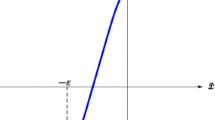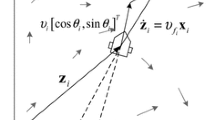Abstract
In mathematical control theory, a Dubins car is a nonlinear motion model described by differential relations, in which the scalar control determines the instantaneous angular rate of rotation. The value of the linear velocity is assumed to be constant. The phase vector of the system is three-dimensional. It includes two coordinates of the geometric position and one coordinate having the meaning of the angle of inclination of the velocity vector. This model is popular and is used in various control tasks related to the motion of an aircraft in a horizontal plane, with a simplified description of the motion of a car, small surface and underwater vehicles, etc. Scalar control can be constrained either by a symmetric constraint (when the minimum rotation radii to the left and right are the same) or asymmetric constraint (when rotation is possible in both directions, but the minimum rotation radii are not the same). Usually, problems with symmetric and asymmetric constraints are considered separately. It is shown that when constructing the reachability set at the moment, the case of an asymmetric constraint can be reduced to a symmetric case.









Similar content being viewed by others
REFERENCES
L. E. Dubins, “On curves of minimal length with a constraint on average curvature, and with prescribed initial and terminal positions and tangents,” Am. J. Math. 79 (3), 497–516 (1957).
A. A. Markov, “A few examples of the solution of a special type of problems on maximum and minimum values,” Soobshch. Khar’kov. Mat. O-va, Vtoraya Ser. 1 (2), 250–276 (1889).
R. Isaacs, Differential Games (John Wiley and Sons, New York, 1965; Mir, Moscow, 1967).
V. S. Patsko and A. A. Fedotov, “Three-dimensional reachable set for the Dubins car: Foundation of analytical description,” Commun. Optim. Theory 2022, 23 (2022).
Robot Motion Planning and Control, Ed. by J.-P. Laumond (Springer, Berlin–Heidelberg, 1998).
S. M. LaValle, Planning Algorithms (Cambridge University Press, Cambridge, 2006).
M. E. Buzikov and A. A. Galyaev, “Time-optimal interception of a moving target by a Dubins car,” Autom. Remote Control (Engl. Transl.) 82 (5) 745–758 (2021).
A. A. Ardentov, L. V. Lokutsievskii, and Yu. L. Sachkov, “Explicit solutions for a series of optimization problems with 2-dimensional control via convex trigonometry,” Dokl. Math. 102 (1), 427–432 (2020).
S. P. Khabarov and M. L. Shilkina, “Geometric approach to solving the Dubins car problem with the formation of program motion trajectories,” Nauchno-Tekh. Vestn. Inf. Tekhnol. Mekh. Optim. 21 (5), 653–663 (2021).
A. A. Zimovets, A. R. Matviichuk, A. V. Ushakov, and V. N. Ushakov, “Stability property in the convergence game problem in the presence of phase constraints,” J. Comput. Syst. Sci. Int. 60 (4), 530–548 (2021).
A. S. Bortakovskii, “Fastest planar motion trajectories with unlimited curvature,” J. Comput. Syst. Sci. Int. 61 (4) 512–522 (2022).
E. Bakolas and P. Tsiotras, “Optimal synthesis of the asymmetric sinistral/dextral Markov–Dubins problem,” J. Optim. Theory Appl. 150 (2), 233–250 (2011).
A. Miele, Flight Mechanics (Dover, Mineola, N.Y., 1962; Nauka, Moscow, 1965).
T. Pecsvaradi, “Optimal horizontal guidance law for aircraft in the terminal area,” IEEE Trans. Autom. Control 17 (6), 763–772 (1972).
V. S. Patsko, S. G. Pyatko, and A. A. Fedotov, “Three-dimensional reachability set for a nonlinear control system,” J. Comput. Syst. Sci. Int. 42 (3), 320–328 (2003).
V. S. Patsko and A. A. Fedotov, “Analytical description of the reachability set for a Dubins car,” Tr. Inst Mat. Mekh. Ural. Otd. Ross. Akad. Nauk 26 (1), 182–197 (2020).
L. S. Pontryagin, V. G. Boltyanskii, R. V. Gamkrelidze, and E. F. Mishchenko, Mathematical Theory of Optimal Processes (Fizmatgiz, Moscow, 1983) [in Russian].
E. B. Lee and L. Markus, Foundations of Optimal Control Theory (Wiley, New York, 1967; Nauka, Moscow, 1972).
A. A. Tolstonogov, Differential Inclusions in a Banach Space (Kluwer, Dordrecht, 2000).
V. S. Patsko and A. A. Fedotov, “Reachability set at a certain time for a Dubins car in the case of a one-sided turn,” Tr. Inst Mat. Mekh. Ural. Otd. Ross. Akad. Nauk 24 (1), 143–155 (2018).
V. S. Patsko and A. A. Fedotov, “The structure of the reachability set for the Dubins car with a strictly one-sided turn,” Tr. Inst Mat. Mekh. Ural. Otd. Ross. Akad. Nauk 25 (3), 171–187 (2019).
Author information
Authors and Affiliations
Corresponding author
Additional information
Publisher’s Note.
Pleiades Publishing remains neutral with regard to jurisdictional claims in published maps and institutional affiliations.
Rights and permissions
About this article
Cite this article
Patsko, V.S., Fedotov, A.A. Three-Dimensional Reachability Set For a Dubins Car: Reduction of the General Case of Rotation Constraints to the Canonical Case. J. Comput. Syst. Sci. Int. 62, 445–468 (2023). https://doi.org/10.1134/S1064230723030115
Received:
Revised:
Accepted:
Published:
Issue Date:
DOI: https://doi.org/10.1134/S1064230723030115




